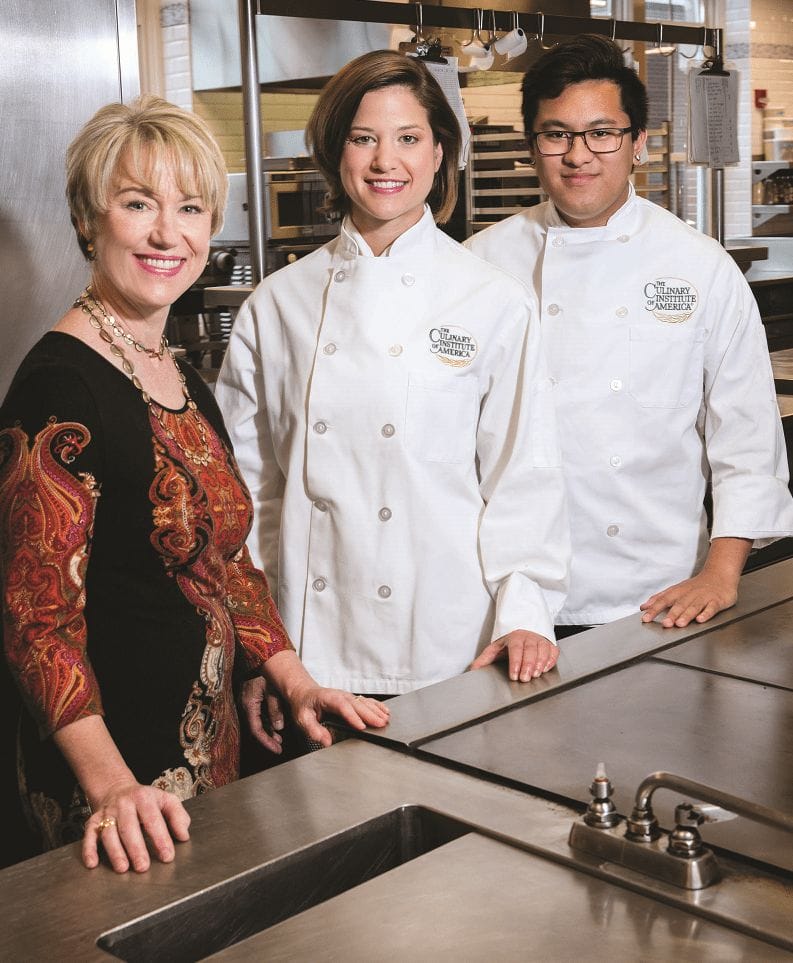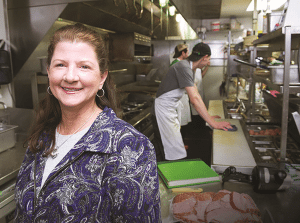 CIA instructor Jennifer Stack with students Mary Ross and Kyle Nguyen. Photo: Brent Herrig
CIA instructor Jennifer Stack with students Mary Ross and Kyle Nguyen. Photo: Brent Herrig PETE Wells has reviewed hundreds of restaurants for The New York Times, but the food critic won’t forget the meal he had at New York’s La Sirena in June 2016 – and unfortunately, that isn’t because of the food. Wells’ son Dexter had accompanied his father on reviews in the past, and was eager to do so again. The writer figured that with its array of easy-to-please Italian offerings, La Sirena was the perfect spot for a family meal.
Wells and his wife and two sons sat down on the terrace of the busy trattoria and, before placing any orders, explained to two servers that Dexter, then 11, had a severe allergy to nuts and seeds.
“We were very careful about what he was getting and the restaurant was fully informed,” says Wells. Since the bread typically brought to each table is coated in sesame seeds, a server offered breadsticks as an alternative for Dexter. Halfway through his second stick, “he appeared troubled, worried and annoyed,” recalls Wells, who watched as Dexter rubbed his lips and began to sneeze. Wells looked inside the breadstick and immediately saw the culprit: whole sesame seeds, baked right in.
Apology and a Promise
The boy recovered after taking an antihistamine, but the incident left a bad taste for his father, who later emailed the B&B Hospitality Group, which at the time owned La Sirena. All staff members at the restaurants run by B&B were fully trained on allergy protocols and accommodations. Yet this happened.
Wells got an apology and the promise of a thorough review of allergy measures. A B&B owner later confessed to frustration with the error, telling Allergic Living: “No matter how many fail-safes and checkpoints we put in place, nothing is foolproof.”
Yet, while an absolute guarantee is not possible, food-service attitudes and efforts are certainly evolving, with more chefs and restaurants regarding allergic or celiac customers as valued patrons instead of nuisance eaters or lawsuits waiting to happen.
The attitudinal shift is thanks in part to the pure numbers of customers with medically required special diets. About 32 million Americans are living with food allergies and three million with celiac disease, and studies suggest these numbers are on the rise. And when they dine out, this growing community takes families and friends with them.
To understand how the restaurant industry is changing – the efforts being made toward better allergy training, policies and procedures, along with the missteps – let’s pull back the curtain on what goes on inside the bustling professional kitchen.
Restaurants May ‘Think’ They Get Allergies
There’s a unique process required for preparing “allergy-safe” meals, explains William Weichelt of the National Restaurant Association (NRA), but the prospect of it can seem overwhelming for some food-service executives. “The biggest concern that restaurants have is how to get started,” he says. “They’re fearful that they need to go and build a brand new kitchen for someone who has an allergy.”
That’s not so, and quality training programs will identify simple and cost-effective accommodations within the existing kitchen, such as frying French fries in a fresh pan rather than a communal deep fryer. Following training, some restaurant chains have instituted efficient procedures from thorough cleaning, to color-coded utensils to indicate allergy and more – all in aid of keeping the allergic or gluten-free customer safe.
Where restaurants can get into trouble is when the staff “think” they know how to handle allergies. “Many folks in the industry believe they already have solutions,” says Betsy Craig, CEO and founder of MenuTrinfo. That company’s AllerTrain certificate program is the gold standard for teaching food-service managers, chefs and employees about handling allergies. Craig has brought training to thousands of restaurant personnel. However, when she engages with staff, it often becomes clear they don’t know as much as they thought.
When she began allergy training in 2010, the main problem Craig noticed was that servers were confidently saying, for example, that pork ribs were safe for those with nut allergies. In fact back then, barbecue sauce widely sold for restaurant use contained tree nuts. Other assumptions she has seen include believing that high heat will destroy food allergens (it won’t) or that peanuts are nuts (they are legumes).
A 2015 survey, published in the Journal of Food Service Business Research, showed that this type of overconfidence persists. In the small survey of 110 U.S. chefs, managers and restaurant owners, 80 percent professed to have received some food allergy training, but there were still significant knowledge gaps – such as half of those surveyed not recognizing that arachis oil is peanut oil, or 40 percent being unaware that soy and fish are among the Top 8 allergens.
 Beckee Moreland from Beyond Celiac leads a gluten-awareness session.
Beckee Moreland from Beyond Celiac leads a gluten-awareness session. Clearing up confusion on what exactly gluten or a food allergen is, and the medical necessity of avoiding gluten (for those with gluten-related disorders) or top allergens (with food allergy) are big components of training, explains Beckee Moreland, who is the director of Beyond Celiac’s GREAT Kitchens gluten-free training program for restaurants, colleges and other institutions. She highlights the distinction between cross-contamination – exposure to bacteria that can make any customer ill – and cross-contact, which is solely a concern for those with celiac disease or food allergy.
“Everything in a kitchen is designed around minimizing food-borne illness, but you’re only minimizing food allergens when that specific person comes in with an allergy and you try and make that accommodation,” says Weichelt, who is director of the restaurant association’s ServSafe Allergens online training program. Craig adds that food allergy training needs to be repeated and refreshed, the same way proper handwashing technique is taught again and again to ensure food safety.
Training the Next Gen of Chefs
Over at the “Ivy League” of culinary schools, The Culinary Institute of America (CIA) in Hyde Park, New York, the next generation of chefs has food allergy and celiac accommodations on the lesson plan – and the ServSafe Allergens program has recently become a requirement for all first-year students.
Student chef Kyle Nguyen has a passion for food and is now in his third year at the institute. However, with his allergies to black beans, fava beans and other legumes, these ingredients are often left off the 20-year-old’s menu. While it can be inconvenient for him, Nguyen’s allergies have helped to educate fellow students. If there is a chance of cross-contact, he says the class now knows to stop, thoroughly clean everything affected, and start again.
His allergies can make him the topic of discussion, but he doesn’t mind. “The fact that the students have an interest could potentially positively impact the life of someone else with allergies,” Nguyen says.
Mary Ross, 30, another CIA student, has grown up witnessing the first big generation of food allergies and celiac disease, and also once worked as the nanny for a child with multiple life-threatening food allergies. She has seen the difference that professional accommodation can make and says: “I want to use my chef powers to make the world a better place.”
That’s a far cry from her own waitressing experience a decade ago. In those days at the steak and seafood restaurant where she worked, if a customer simply asked for something to be served on the side – let alone be made allergy safe – she knew it would be a big problem in the kitchen. “Coming back and having to interrupt the service about anything was a huge no-no,” she recalls.
Like others in the restaurant industry, she sees a shift in attitude toward greater openness in adapting meals for patrons. “Chefs used to have a reputation that made some people afraid to ask for a special order or modification on a menu item, but now many chefs are eager to accommodate with a higher level of hospitality,” says Chef Bruce Mattel, the CIA’s senior associate dean. “Chefs do recognize it’s more important that a customer be safe and have a great time, than for them to serve their ego.”
Taking the time and effort to establish good food allergy accommodations can also make economic sense. Paul Antico, founder of AllergyEats, the Yelp-style online guide for allergic consumers, notes that almost 6 percent of Americans have a food allergy or celiac disease – and their buying power is amplified because their needs will sway the decision of where a whole party will dine.
For instance, three out of Antico’s five children have food allergies, but his family won’t eat at a restaurant unless it can accommodate the entire crew. He says a survey conducted through AllergyEats.com, found that the food allergy community is also 40 percent more loyal to their favorite restaurants when compared to non-allergic customers.
From Safe Storage to Station, to Table
 Betsy Craig developed MenuTrinfo's program.
Betsy Craig developed MenuTrinfo's program. The parks’ restaurants invite anyone with dietary restrictions to “be our guest,” despite serving millions a year. Chef Joel Schaefer, Disney’s former special dietary manager, explains that handling the volume of dietary requests comes down to understanding “the flow of food.”
To Schaefer, whose company Your Allergy Chefs specializes in special diets training for professionals, the flow of food begins with knowing the products the kitchen receives from vendors, and ensuring all ingredients are properly labeled. From there, the food is stored. This raises questions such as: are ingredients organized so eggs are safe from breaking onto foods that are naturally free of allergens? Storage issues extend into the kitchen, with concerns like flying flour or open containers of nuts or seeds that could find their way into a dish.
For these reasons, Schaefer says when a special needs order comes in, the person preparing the meal cannot just wipe off their board and get started. The station and utensils must be washed and sanitized and new gloves are worn, in order to minimize the risk of cross-contact.
The “flow of food” uses different tools and techniques depending on the restaurant. “Nothing is 100 percent,” says Craig, “but there’s definitely some great new stuff.” Some servers carry a spreadsheet with all of the menu items and their allergens to help determine if a dish is safe for an allergic customer.
Some establishments employ tickets with the word “allergy” stamped in red on them, or use prepared “allergy kits” with sanitized cookware and utensils or, where possible, create a separate cooking station for allergy orders. Craig’s personal favorite is the range of tools now available in purple, denoting that they are for allergy-safe meals. Once the meal is ready, some restaurants will also flag the dish with a sticker to clearly distinguish the “safe” plate.
Throughout the entire process, communication from front to back of house is crucial, says Schaefer. A breakdown is what leads to incidents. In fact, this may have been the case at La Sirena with the Wells family’s experience.
An investigation by the restaurant revealed a leading theory of what likely went wrong: A few weeks before the critic and his family visited, the restaurant changed its breadsticks to a type that contains sesame. The chef may not have informed all of the staff, and since the original breadsticks were sesame-free, the server did not double-check before offering the sticks to Dexter.
Fortunately, the boy’s reaction wasn’t serious, but for someone else, that error could have triggered anaphylaxis. Still, what’s different now from years gone by was the level of follow-up. B&B Hospitality Group has a director of environmental health, whose job includes allergy and celiac training, with reminders and annual refreshers, as well as investigation of any incidents. She conducted the internal review of the mistake with the Wells family, meeting with the entire La Sirena team about it.
Restaurants ‘Duty of Care’ with Allergies
 Chef Ivy Stark of New York's Dos Caminos restaurants.
Chef Ivy Stark of New York's Dos Caminos restaurants. “It’s got to be really tough to not see your food prepared if you have a life-threatening allergy,” she says. Knowing every ingredient in each dish she creates and having an accommodations policy – including a chart that indicates which Top 8 allergens are in each menu item as well as an ordering system that clearly labels each allergy order and plate – are part of Stark’s effort to make customers feel more comfortable at Dos Caminos. And those policies are put into practice multiple times each shift.
The respect with which many savvy chefs today treat severe allergies and celiac disease does not surprise Jennifer Stack, an associate professor at the CIA. “We’re in the hospitality industry, not the hospital industry,” she pointedly notes.
Many front of house staff take such conditions seriously, too. Cecilia Fischer has worked as a waitress at Tarry Lodge, just north of New York City, for eight years. She receives bi-annual allergy training and knows to inform management and the chef about any dietary restrictions and to create a special order ticket. She sees accommodations as a key part of her job. “If someone tells me they’re extremely allergic to shellfish, it’s my responsibility to do the right thing by them.”
An Allergic Diner’s Own Role
Clearly the restaurant business still has a ways to go, however change is happening. With good “food flow” procedures in place, chefs and restaurant staff are increasingly able to handle allergy-friendly meals, but this does require the help of the customer. “It’s 50-50,” says Schaefer. “The guest has 50 percent of the responsibility, making sure they give the chefs all the information possible.”
At Dos Caminos, Stark noticed with concern that patrons sometimes will treat the menu like a recipe book. “People often just assume that their meal will be safe because it didn’t list whatever the allergen is on the menu,” she says. In fact, menus often showcase key components, but Stark says many ingredients are not shown. So it is crucial that customers disclose any diet restrictions.
In recent years, the requests have become more complicated for chefs. Some people follow the gluten-free diet just as a trend, and customers may refer to their preferences as “allergies”. Daniel Maggio, the executive chef at Nick & Stef’s Steakhouse in Madison Square Garden, recalls carefully preparing a dairy- and gluten-free meal only to later witness the customer digging into a friend’s cheeseburger. Despite the frustrating fakers, Maggio and Stark both err on the side of caution, taking every request seriously.
So how can allergic or celiac guests help restaurants better serve them? “There has to be some level of self-advocacy, meaning that the people with allergies need to know what questions to ask,” says the CIA’s Mattel, such as inquiring about ingredients and cooking procedures. Chefs recommend informing an establishment ahead of time about allergies, avoiding peak dining hours and, of course, carrying an auto-injector.
Maggio adds that when he eats out with his daughter, who is allergic to chickpeas and peanuts, he doesn’t mind a wait. That indicates the kitchen is taking precautions. “If you order something and you have an allergy and it comes out right away, you might want to pause,” he says.
Allergic customers and chefs also need to know when to say “no.” Maggio reviews a restaurant’s menu beforehand. If there are allergens in both cold dishes and entrees, he says this can signal that such foods are spread throughout the kitchen, making it an unsafe choice for his daughter.
On the chef ’s side, safety is the priority, but removing certain ingredients doesn’t mean the quality of the dish should suffer. Creativity is still key when serving allergy- or celiac-safe meals, says the CIA’s Stack. “One of the things we emphasize is that when you’re serving someone with a special dietary need, you cannot lower the standard for how it tastes or how it looks.”
In the first semester at the culinary school, Stack poses a seemingly impossible task to the students in her nutrition class: create an authentic Italian menu that is completely gluten-free. The white-coat-clad students immediately jump to buying certified gluten-free pasta. But Stack, who is also a registered dietitian nutritionist, challenges them to see beyond the products available. She gets them to look closely at ingredients, many of which are naturally gluten-free. Soon grumbles become sparks of inspiration, with student menus including dishes like polenta, risotto, or chicken with roasted potatoes.
Knowing first-hand how huge a difference the hospitality industry can make for those living with allergies, Nguyen plans to follow in the footsteps of chefs like Schaefer, Maggio and Stark. Once he completes his studies at the CIA, he intends to help food-allergic and celiac customers feel safe in his dining room. He dreams of eventually opening an establishment where he can make that a priority.
“I want to make a restaurant that people with food allergies feel really comfortable going to because they know they will be taken care of. They don’t have to be afraid.”
With consulting assistance from Sloane Miller, who specializes in food allergy management at Allergicgirl.com.
See Also:
Restaurant Rules: Why Allergy Accommodations Vary
Guide to Dining Out Safely with Food Allergies





